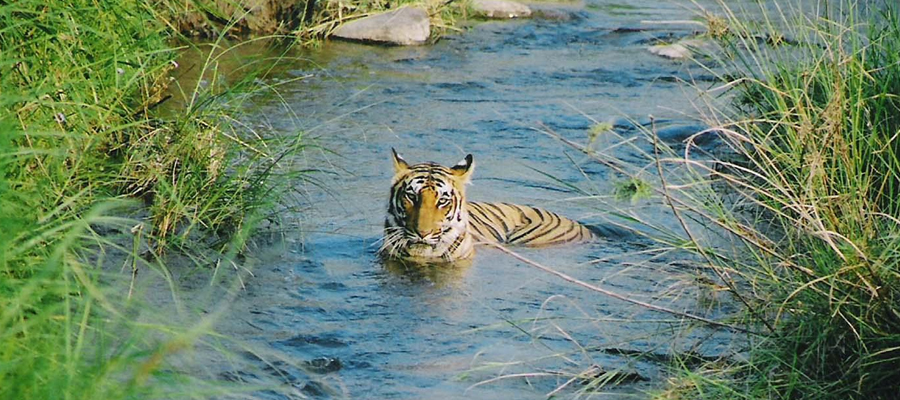
Overview
Corbett Tiger Reserve or Jim Corbett National Park India is the oldest and the most popular tiger reserve where a sizeable tiger population to the tune of 220 thrives in peace. Though tiger sightings are few and far between given the dense and sprawling forest cover and total lack of tracking or baiting of big cats, nonetheless the reserve attracts myriad of tourists every year to soak in the serenity of its breathtaking landscapes, as well as spotting a remarkable variety of wildlife, including more than 600 birds' species!
Introducing Corbett National Park
The Corbett National Park in Northern India is located in the foothills of The Himalayas on Ramganga River, in the Kumaon region of Uttarakhand. The present territory of the national park stretches over 521 sq km of core forest area and 798 sq km of buffer area. The area covers an eclectic mix of Himalayan and plains like terrains. The composite area of the Corbett forest reserve, in fact, sprawls over 1288 sq km, including the terai, the rivers, the streams, the hilly ridges and the Himalayas negotiating the terrain. Indeed, the park is endowed with an interesting juxtaposition of distinct habitats, thus home to all kinds of flora, fauna and avifauna typically found in Himalayan terrains and plains. The most famous wildlife in the park, however, remains the Bengal Tiger (220) and the Asiatic Elephants (200-300).
Corbett national park was originally found in 1936 as the first ever national park in India by the name Hailey National Park. Later in time, however, the park was renamed twice – first to be called the Ramganga National Park and yet again in 1956 to its present name, after the popular British hunter-turned-conservationist Jim Corbett (1875-1955), who played a powerful voice in getting the Kumaon forest cover designated as a national park.
As history has it, Jim Corbett was a British hunter often reverently approached by the local people to bring down the man-eaters of the Kumaon jungles that stalked their homes. Over time, Corbett took to wildlife photography and writing than shooting innocent wildlife with his gun and became a prominent missionary for the conservation of the forests and the tigers. His book titled "The Maneaters of Kumaon" became a bestseller back in 1944 and witnessed international fame, securing Kumaon a place on the global map. The park was established as the first ever Project Tiger Reserve in Asia in 1973.
Heritage Places / Sightseeing in Corbett National Park
Jim Corbett National Park Attractions include for pampering the visitors' senses with beautiful sceneries, fresh air and spotting a plethora of wildlife in their natural habitat. As of now, selected few areas of the Corbett Tiger Reserve are available for tourists to explore. The national park is divided into six mutually exclusive forest zones for tourism viz. Bijrani, Dhela, Dhikala, Domunda, Jhirna and Sonanadi.
On the northwest of Ramnagar, Dhikala is the most popular zone in the park that enjoys maximum concentration of wildlife. While rhesus macaques and langur monkeys are present everywhere across the reserve, in Dhikala tourists can hope to spot serious wildlife including tigers, leopards, elephants, sloth bears, jackals, monitor lizards, and wild boars. Among antelopes, one can hope to see spotted dear (chital), hog deer, barking deer and sambars. The muddy banks of Ramganga River are excellent for spotting long-snouted gharials, marsh crocodiles, pythons, cobras and romp of otters. The Ramganga reservoir in the tourist zone is home to mugger crocodiles and at least 600 species of pretty birds including crested serpent eagle, the pied kingfisher and Himalayan grey-headed fishing eagle.
Chances of spotting any serious wildlife in Jhirna and Dhela are really slim. It is, however, reported that plans are underway to construct a fenced section for rescued tiger and two fenced nature trails for bird-watching in Dhela.
Those interested in the life of Jim Corbett should not miss exploring the Jim Corbett Museum at Kaladhungi, the former house of Corbett converted into a museum for public at large.
How to reach Corbett National Park
By AirThe closest airport to the Jim Corbett National Park is Pantnagar, which is about 80 km from the destination. The schedule of flights here is not reliable and as such the airport is not relied upon by tourists.
By RailRamnagar is the nearest railhead to Corbett Forest Reserve, located just 50 km from the main campsite at Dhikhala zone. Frequent buses and private jeeps run between Ramnagar and Dhikala.
By RoadThe park is conveniently connected by road from Delhi via Moradabad. Moreover, there is daily bus service between Delhi and Ramnagar, as well as, Ranikhet and Ramnagar
What is the best time to visit Corbett National Park?
During summer season from April to June, the temperature in Jim Corbett National Park remains quite high and thus hot. The season is ideal for spotting elephants around water bodies.
The park observes clear days and cold nights during the winter season, which spans from October to March. It is an ideal time for bird-watching and gazing at mountainous sceneries.
Monsoon season from July to September witnesses humid days but pleasant nights. It is a good time to go for rafting on Kosi River or taking walks/ treks and watching flora. During the monsoon season, Jim Corbett National Park timings do not permit entry in Dhikala zone for tourism. However, Jhirna and Dhela on the south of the park remain open for tourists throughout the year.
Dhikala opens from 15th November till 15th June. Only overnight guests are allowed entry in Dikhala during the period. Besides, guests who book one of the one-day Jim Corbett National Park tour packages from the park's reception (located just opposite to Ramnagar bus stand) are also granted entry in Dikhala zone

